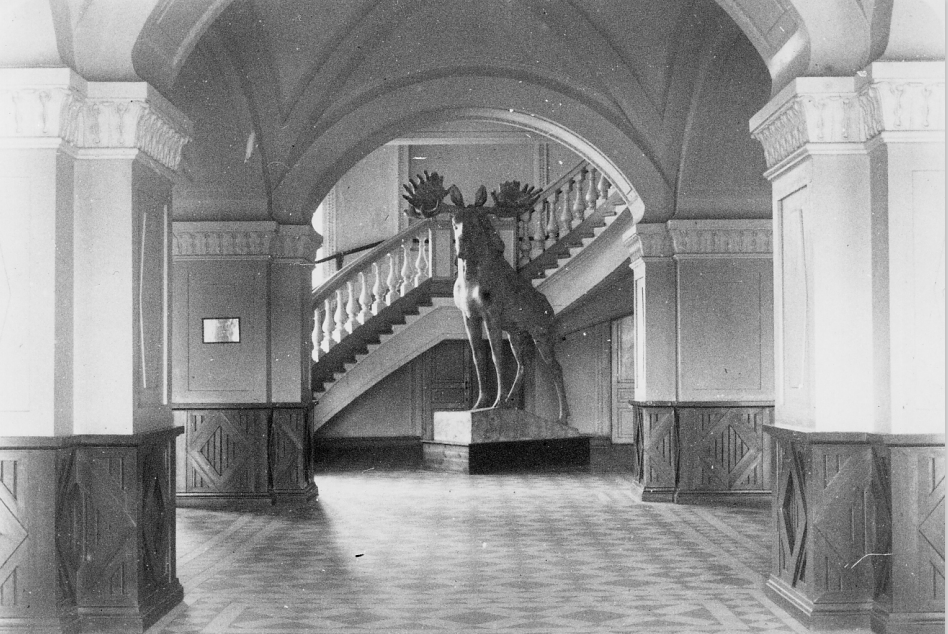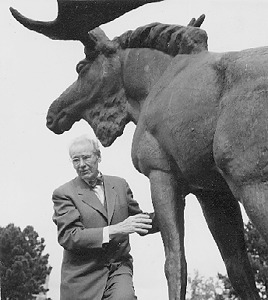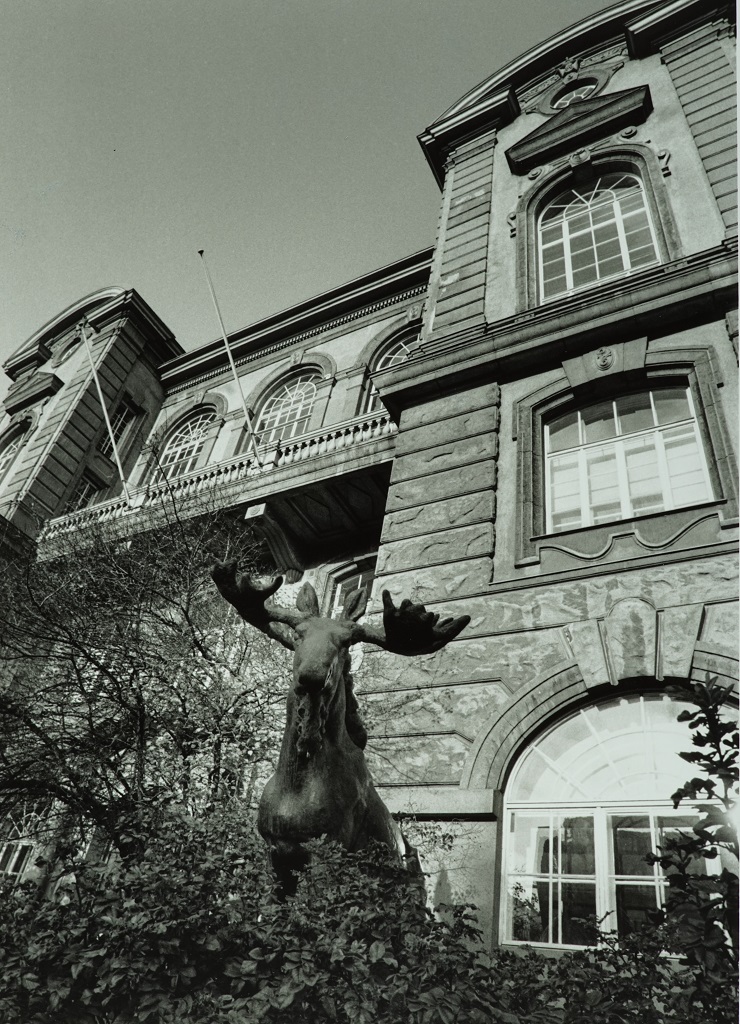June is a great time to get out and about in nature, but if you are in Finland, watch out for roaming elk! However, there is one elk who never moves from his position in the Töölö district of Helsinki. Many people are familiar with the Object of the Month for June: it is the Elk sculpture that stands proudly in front of the Finnish Museum of Natural History. Created by the Finnish sculptor Jussi Mäntynen (1886–1978), this realistic depiction of an antlered bull elk is included in the University of Helsinki art collection.

An elk’s life
From the very beginning, visitors to the Natural History Museum have been welcomed by an elk sculpture, albeit initially a plaster version placed in the lobby. Jussi Mäntynen created the plaster sculpture, close to four meters in height, in 1923. The following year, the sculpture was on display at the Nordic hunting exhibition of the Finnish General Hunters’ Association. The exhibition was held in the facilities of the University of Helsinki’s gymnastics department on Fabianinkatu street, in a courtyard building designed by Carl Ludvig Engel, which was demolished in the 1930s to make way for the extension of the University’s Main Building. In connection with the hunting exhibition, the artistic qualities of Mäntynen’s work were widely praised, and a photo of the sculpture even graced the cover of the exhibition programme leaflet. Mäntynen donated the plaster sculpture to the Zoological Museum in 1928 and it remained on display in the museum lobby until the end of the 1960s.
The University of Helsinki’s Zoological Museum was opened to the public in 1925. Two years earlier, the University had acquired the neo-baroque building of the Gymnasium of Alexander, a Russian school for boys, which had been completed on Pohjoinen Rautatienkatu street in 1913. This building came to house the Department of Zoology and its national collections, which had previously been cramped into the attic of the University’s Main Building. Now a part of the Finnish Museum of Natural History under the auspices of the University of Helsinki, the Zoological Museum was renamed the Natural History Museum in 1996 to better reflect the nature of the collections and exhibitions.

Four bronze casts of the Zoological Museum’s plaster sculpture were later created. The sculpture had already been admired in the abovementioned hunting exhibition, and it was suggested in newspapers that it be cast in bronze and placed in Kaivopuisto Park in Helsinki. However, the first bronze cast was erected in Vyborg in 1928 and the second in Lahti in 1955 following a donation from former Vyborg residents. In 1969 the City of Turku also commissioned a bronze sculpture which was installed in Kupittaa Park. After the University of Helsinki Senate allocated funding for a bronze version, it was finally also erected in its current location in Helsinki with permission from the relevant city committee, and was unveiled in autumn 1972.
Jussi Mäntynen’s winding career path
Mäntynen studied art in the early 1900s, initially at the drawing school of the Finnish Art Society and at the central school of the Finnish Society of Crafts and Design with the aim of becoming a carpenter and, later on, in the studios of Akseli Gallen-Kallela and Alpo Sailo. Mäntynen’s elk sculpture was inspired by the Elk of Hiisi from the national epic of Finland, the Kalevala, and has clear references to Gallen-Kallela and Sailo, who also drew their inspiration from the same work. In the Kalevala poetry, the Elk of Hiisi is a fast and strong otherworldly animal who is almost impossible to catch.

Nature and animals played a key role in Mäntynen’s career. As a young man, he hunted birds and learned to draw and stuff them. Later, when studying art, he got a job at the University of Helsinki’s Department of Zoology, first as a preparator’s assistant in 1910 and later as a permanent taxidermist in 1919. By the time he was employed by the Zoological Museum, if not earlier, he familiarised himself thoroughly with animal anatomy. Mäntynen was highly skilled in capturing the movement of animals as both a sculptor and a taxidermist. He placed stuffed animals on display in exhibition facilities by arranging them in groups and as dioramas, which at the time was new to natural history museums. He also sought further learning and inspiration for his work and art by travelling extensively.
Various sources indicate that Mäntynen gave up his career after two decades to devote himself to his artistic work, but this change of career was, in fact, somewhat dramatic. Mäntynen had only recently gained international visibility as an artist in connection with an exhibition held in London in 1939 when his supervisor at the Zoological Museum enforced stricter working conditions and increased his hours significantly from what had been previously agreed. Because this would, in effect, have prevented Mäntynen from working as an artist, he considered his supervision’s decision as a sacking. In an agitated state, he resigned from the job that had been important to him, crushed his unfinished works with a sledgehammer and moved to Sweden, where he came to achieve considerable success as a sculptor.
Mäntynen later talked about his dream of again holding an academic position. He was recompensed when he was granted the title of professor in 1948. According to Mäntynen, Antti Tulenheimo, then chancellor of the University of Helsinki, had even told him at a meeting that he considered Mäntynen to have been poorly treated by the University. Mäntynen also described how he had eventually offered his former supervisor the ‘hand of forgiveness’. He returned to Finland at age 81, but shunned Helsinki and moved to Turku, which also received a large number of his sculptures as a donation.
The iconic elk
When Mäntynen was interviewed by the press due to receiving the title of professor, he noted that he had always found animals more fun than humans. In fact, his sculptures focused exclusively on animals. Of wild animals, the elk, the bear, the crane and the Eurasian lynx were his favourite subjects to which he returned throughout his career. Mäntynen’s outdoor sculptures in Helsinki include The Young Elk (1929) in Kaisaniemi Park and The Bear on the Anthill (1931) in Karhupuisto Park. It was precisely in the early decades of the 1900s, when Mäntynen also created the Elk sculpture, that public animal sculptures became highly popular in Helsinki and elsewhere in Finland.
The Elk, also described as the symbol of the Natural History Museum, is probably the best known of Mäntynen’s works. Its significance for locals was demonstrated when a journalist from the Helsingin Sanomat daily, exploring readers’ memories of the sculpture, contacted the Helsinki University Museum in late 2020. Many had doubted the official year, 1972, indicated for the sculpture’s completion, because they remembered having seen the sculpture outside the museum in the previous decade. It is likely that they confused the bronze sculpture with the plaster version that stood in the museum lobby for many years. But these memories also attest to the inextricable link between Jussi Mäntynen’s Elk, the Natural History Museum and the Helsinki cityscape.

Marja Niemi, curator
Translation: University of Helsinki Language Services.
Sources:
Bonsdorff, Bengt von: Jussi Mäntynen. Kuvanveistäjä Jussi Mäntysen eläinveistoksia. Art Museum Gösta Serlachius, 1995
Website of the National History Museum: https://www.luomus.fi/en/natural-history-museum-building
Lintunen, Virpi and Elina Tommila: Kirahveja kimnaasissa exhibition manuscript, Finnish Museum of Natural History, 2008–2009
Kaksi ammattia – kaksi identiteettiä? Jussi Mäntysen kehitys eläintentäyttäjästä kuvanveistäjäksi. Master’s thesis, University of Helsinki, Art History, 2008
Newspaper articles:
Helsingin Sanomat, 13 September 1963, p. 9
Helsingin Sanomat, 3 November 1969, p. 16
Uusi Suomi, 13 April 1967, Issue No 80, p. 3
